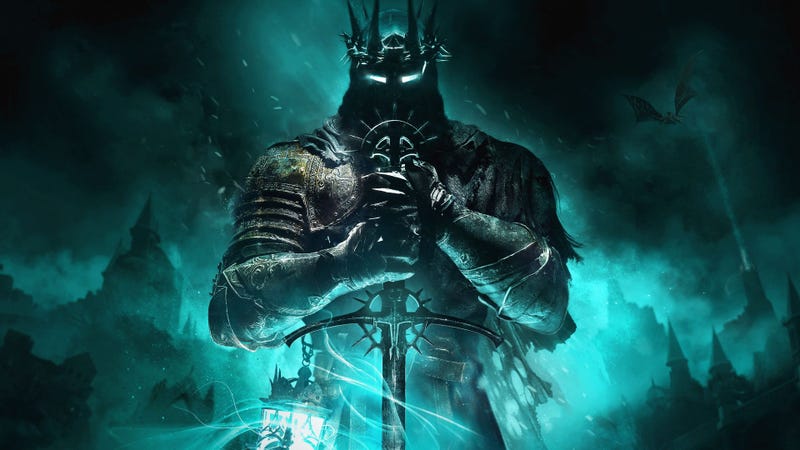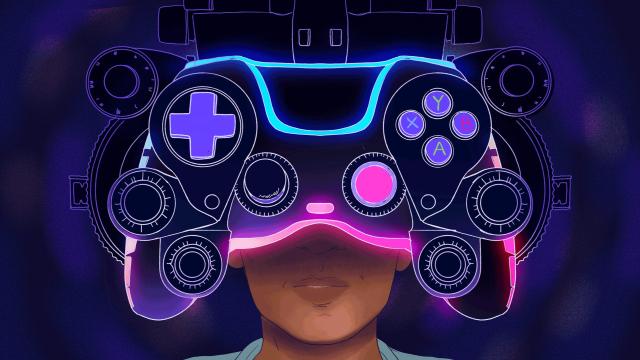As Kotaku’s resident Soulsbud, I was stoked to check out the action-Soulslike RPG Lords of the Fallen when it debuted back in mid-October, so I booted it up and immediately navigated to the settings menu. This is always my first stop when starting any game, to ensure I can actually play the thing.
But that wasn’t the case with developer CI Games’ new hotness. Despite fiddling with the minimal accessibility options, I still found myself unable to read much of the text, let alone move through most of the environments. It was a frustrating predicament, particularly because I’ve enjoyed my time facing the game’s terrifying enemies, but I had to put Lords of the Fallen down due to my worsening vision.
The bane of my existence
For those that don’t know, I have keratoconus. As the American Academy of Ophthalmology states, the disease causes the cornea—the clear window that covers your eye kind of like the lens of a camera—to bulge and thin out into a cone-like shape. This results in blurry and distorted vision and, if left untreated, near-total blindness. (In my case, there are scars running down the middle of my corneas contributing to my low vision.) It’s a rare condition that, according to Johns Hopkins Medicine, affects about one in every 2,000 people. Keratoconus is a degenerative, nonhereditary, and progressive disease with no known causes and zero cures. Sure, there are surgeries to treat it, but unless you do a full corneal transplant—a rather invasive procedure that replaces the damaged cornea with donor tissue with a host of risks, including bleeding, infection, and even worse vision—you’re screwed once you’ve been diagnosed.
At least, that’s how I felt when I was diagnosed as a 15-year-old high schooler. Maybe this is cliché to say, but I had perfect vision growing up. Everything was crystal clear, though my pollen allergy occasionally made my eyes itchy and watery. I’d excessively rub them to the point of eye fatigue, but I never thought much of it. Until one day, after going to sleep with 20/20 eyesight, I woke up with extremely blurred vision. It appeared as if someone smeared Vaseline all over my eyeballs or like I was looking through a heavily rained-on windshield; I couldn’t see anything, and I couldn’t understand why I couldn’t see anything.

Thanks to my late grandma’s diligence and persistence, though, we found a professional who gave some clarity after months of searching: “I’m sorry, but they’ll never see clearly again.” At least, I think that’s what the white coat said; I cried nonstop as I tried to grapple with the revelation of the disease and the reality of the situation.
To stop the disease’s progression, I was scheduled to go into eye surgery in early October, but the doctor said my left eye was “too hazy and enflamed” for the procedure because of excessive contact wear and technology use. I wear these special contacts known as scleral lenses designed specifically for my misshapen eyes—and they aren’t covered by insurance. This means that, in order to function like an independent adult, I’ve gotta pay upwards of $US1,000 for what amounts to hard-plastic magnifying glasses that sit in my eyes for hours at a time. The doctor suggested I come back in one week to reschedule the surgery, which went well, other than the weeks of pain I endured.
The break was nice; I really needed the rest. However, with the month that I was gone, I was reminded about just how debilitating my deteriorating eyesight is and how difficult gaming has become. Gaming and writing, hobbies I loved so much that I turned them into my profession, feel like impossible activities these days. It sucks.
Keratoconus has fundamentally changed playing games for me. I adjust the brightness and contrast to make things brighter than they should be because games that are too dark are hard for me to navigate through. (Though games that are too bright also sear my already fried eyeballs.) If large text is an option, I crank that to the biggest font size possible, even if it creates weird formatting issues with letters and sentences breaking at unreadable points. Choosing between Performance or Quality modes—in-game settings that prioritize frame rate or visual fidelity, respectively—is tough. I need the performance for smooth reactions and the quality to see what I’m reacting to, so it’s like being caught between a rock and a hard place.
Gaming while blind
When accessibility settings aren’t available or are hidden, I tend to avoid that game despite it being something I’m stoked about, such as Lords of the Fallen or Tears of the Kingdom. I can’t really do anything without my contacts, meaning I couldn’t just get a couple of hours of, say, Starfield in if I wasn’t wearing them. But wearing my contacts for too long causes that painful “hazy and enflamed” issue my ophthalmologist warned about. It’s a real struggle.
Another major bummer is the continued lack of standardized accessibility offerings in games. Yeah, there is a set of developer-friendly guidelines published by a group of studios, academics, and specialists to make implementing these features more straightforward, but they haven’t been widely adopted.
There are some truly exceptional games that’ve pushed accessibility forward recently, including Marvel’s Spider-Man 2, Forza Motorsport, The Last of Us Part 2. But not every developer has the resources of a major first-party studio. Companies such as Microsoft and Sony are dropping accessibility controllers, but not everyone’s doing that. (Looking at you, Nintendo.) What you get is a patchwork approach to accessible gaming that’s certainly getting better, but is still nowhere near where it could or should be.
Will I stop playing video games? Hell no. Will I stop writing? Same answer. But even now, as I type this, my scleral lenses are drying my eyes out, making it tough to see what I’m putting on the page. I hope to keep gaming well into old age, even though I’m constantly learning that the industry—and life in general—isn’t designed for disabled folks.
Let’s not forget that there’s good work being done, though. Disability advocates such as Brandon Cole—a blind consultant on TLOU 2 and Forza Motorsport—and Steve Saylor, who’s working with Raven Software on Call on Duty, have helped create meaningful change for folks who have low vision like myself. Within the last several years alone, organizations like The AbleGamers Foundation, categories such as The Game Awards’ Innovation in Accessibility trophy, and Microsoft’s online developer resources for gaming accessibility have put disability champions in a better position to advocate for much-needed change. It’s thanks to them and their work that accessibility is getting more attention than it ever has from developers and players alike.
But the ground has only recently been paved, and the road to cover is miles long. If the industry hopes to cater to everyone, as is often touted, then disabled players need to be considered and heard more consistently, or gaming will remain an elitist club. Now is the best opportunity we’ve ever had to make a universal accessibility standard a reality. So let’s seize it.

Leave a Reply